What Is Acorn Squash And What Does It Taste Like?
There are more than 100 different types of squash out there on this bountiful planet of ours (via Allrecipes), and while it's unlikely you'll ever come across all of them, you can still be forgiven for being a bit overwhelmed by the couple dozen different types of squash regularly available in America. A few types of squash are so common as to be taken for granted, such as butternut squash, spaghetti squash, and, of course, the classic zucchini (which is indeed a squash, albeit one without the identifier in its name).
The acorn squash is a common but less well-known member of the cucurbita family of gourds, a group including both ornamental and edible plants, including summer and winter squash and pumpkins (via NC State). Also known as the pepper squash or by its Latin name, Cucurbita pepo L var. turbinata (via Candide Gardening), the acorn squash gets its common name thanks to its resemblance to an acorn. It is a member of the winter squash segment of the larger Cucurbita genus (via Healthline), as are pumpkins, butternut squash, and several other common varieties.
In shape, these relatively diminutive squash look much like an acorn that's had its cap removed, thus the name, though in shape they bear an even closer resemblance to their "relative" the pumpkin, thanks to their ridges and woody stems. In terms of color, a mature acorn squash is usually a deep green, often with patches of vibrant orange.
What does acorn squash taste like?
An acorn squash eaten raw — which can be done safely, according to Verywell Fit — tastes mild but bitter, and even slightly astringent. You can assume going forward that when we talk about tasting and prepping and generally using acorn squash, we are speaking of it as cooked.
Acorn squash is not bursting with flavor, frankly speaking. The "meat" of an acorn squash has a mildly buttery flavor and is similar in palate profile to a butternut squash, pumpkin, and zucchini, albeit with an even milder taste than those and other types of squash (via Simply Healthy Family). Where the acorn squash stands out is in how well it can adopt and complement other flavors.
An acorn squash can be sweetened with ingredients like maple syrup or brown sugar, it can be cooked along with onions, pepper, and meats to be take on a more savory profile, or it can be buttered and spiced for a balance of sweetness and savory that is perfect for soups, stuffed entrees, and more. Beyond being used as an ingredient in a recipe, an acorn squash also makes a great vessel for serving other foods, especially when foods are cooked right within the hollowed out center of the squash. Thanks to its mild flavor, the acorn squash will not have much affect on ingredients cooked in proximity to or even within its own flesh, though as noted it will take on the flavors of such foods.
Three ways to cook acorn squash
OK, so now we know a bit about the acorn squash — this mild tasting, but flavor-ready member of the Cucurbita genus. But how do you cook an acorn squash?
An acorn squash can be prepared in myriad ways, from use in a soup to grilled on a barbecue to steaming and the list goes on. But for those just getting used to cooking with the vegetables, there are three simple approaches to consider when it comes to cooking acorn squash.
Arguably the easiest way to cook acorn squash is to roast it, and roasting an acorn squash is especially convenient (and tasty) because it allows for other foods to be cooked right inside the hollow of the squash.
To roast an acorn squash, simply slice the squash in half, scoop out the seeds and the soft flesh connected to those seeds, and lightly brush the interior with oil or butter (and sprinkle on a bit of salt, too), then place the halves cut side up in an oven at 400 degrees Fahrenheit and let it cook for 45 minutes (via Verywell Fit). For this roasting, you can of course use all sorts of spices, sweeteners, add other ingredients, and so forth, but that's your basic approach.
To cook acorn squash in the microwave, again slice the squash in half and remove the seeds and soft flesh, then brush on oil or butter. Now place the halves on a plate or shallow dish and microwave on high for 10 minutes (via Food). If you can only fit one half, note that the time may need to be reduced.
To sauté acorn squash, halve the squash and remove its seeds, then remove the harder green skin with a vegetable peeler. Now cube the squash into larger bite sized pieces, then cook those in a pan prepared with cooking spray, oil, or butter and a bit less than a cup of broth. Cook the cubed acorn squash over medium heat, stirring often, for about 15 minutes, noting that most of the liquid will cook off and the cubes will lightly brown in places (via Fresh Easy Meals).
The health benefits of acorn squash
An acorn squash is a great source of many essential vitamins and minerals. This high-carb vegetable (which is in fact technically a fruit, but is not treated as such in culinary terms) delivers nine grams of fiber per one cup serving, according to Healthline, and also includes two grams of protein and 30 grams of carbs in the same serving, which will net about 115 calories.
Along with those modest 115 calories per one cup serving, an acorn squash will give you 18 percent of your daily recommended value of vitamin A, a solid 37 percent of your daily needed vitamin C, 23 percent of your vitamin B1, and 20 percent of vitamin B6. It is also a great source of magnesium, manganese, and potassium, delivering about a quarter of your daily needs for each in that same serving size.
Acorn squash is also a good source of antioxidants that can protect various cells in the body against damage and, thanks to its high fiber content, it's a great food to eat to promote digestive health. According to Organic Facts, regularly consuming acorn squash may lead to improved eye health, better blood sugar regulation and improved circulation of the blood, and to a healthier immune system, just to highlight a few benefits.
When is acorn squash available and how to know it's ripe
These days, with foods shipped all over the nation and around the globe, and with greenhouses, fertilizers, irrigation, and other modern advances to the cultivation of foods, you can likely find acorn squash available all year round if you hit up a grocery store or two or three. For fresh acorn squash at its peak for flavor and nutrients (think farmer's market instead of supermarket, e.g.), you should stick with sourcing the squash during traditional acorn squash season, which means harvesting from the early fall into the midwinter in North America (via The Spruce Eats).
To choose a ripe acorn squash, look for one that weighs between two and three pounds and feels heavy and solid. The skin should be firm and without dimples or soft spots, and it should be dark green and dull, without a shine or sheen, which may indicate an immature squash or the application of wax (via The Spruce Eats). A few bright orange patches show a mature squash and are welcome — a large portion of the squash being orange (approaching or more than half) means the acorn squash is beyond ripe and will likely be drying out and losing flavor.
When selected properly, an acorn squash will keep for about four weeks in a cool, dark space — think chillier than room temperature, but note that these squash will only keep well in a fridge for about two weeks. You can freeze cooked acorn squash for up to a year.
How to grow acorn squash yourself
The first thing to know about growing acorn squash (or any squash, really) is that you need a lot of space. In fact, according to Gardening Know How, "You'll need about 50 square feet" for a single planting plot, within which you can plan to grow just two or three acorn squash plants. You can grow them on a trellis system if you have limited space but really want to grown squash, for the record. Either way, these plants need lots of sun and a nutrient-rich soil.
To grow acorn squash, wait until after the last frost of the season and until ground temperatures are routinely above 60 degrees. Then build up a small mound several inches above the ground (or planter bed) level and sew a half dozen acorn squash seeds into the mound, placing them one to two inches under the top of the mounded soil. Water daily, watering enough so that the soil remains moist.
You can expect sprouts within one to two weeks, and within two weeks after the seeds sprout, plan to remove all but the healthiest two or three acorn squash sprouts. Continue watering the plants enough to keep the soil moist as they grow over the coming weeks and months. You can expect to be harvesting mature acorn squash about 12 to 13 weeks after the first sprouts poke up (via From Seed to Spoon), and try to harvest all of the squash before the first serious frost of the season.





